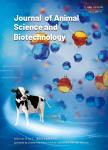Heat shock protein family D member 1 in boar spermatozoa is strongly related to the litter size of inseminated sows
Heat shock protein family D member 1 in boar spermatozoa is strongly related to the litter size of inseminated sows作者机构:Department of Animal Science&Technology and BET Research InstituteChung-Ang UniversityAnseongGyeonggi-do 17546Republic of Korea
出 版 物:《Journal of Animal Science and Biotechnology》 (畜牧与生物技术杂志(英文版))
年 卷 期:2022年第13卷第4期
页 面:1045-1055页
核心收录:
基 金:supported by the Basic Science Research Program through the National Research Foundation of Korea(NRF) funded by the Ministry of Education(NRF-2018R1A6A1A03025159)
主 题:Fertilisation HSPD1 Male fertility Sperm motility Sperm RNA
摘 要:Background:Sperm quality evaluation is the logical first step in increasing field *** contain cytoplasmic organelles and biomolecules known as sperm-intrinsic factors,which play key roles in sperm maturation,sperm-oocyte fusion,and embryo *** particular,sperm membrane proteins[e.g.,arginine vasopressin receptor 2,beta-actin,prohibitin,and heat shock protein family D member 1(HSPD1)]and RNA could be used as functional indicators of male *** sought to clarify the effects of differential mRNA expression of selected genes on several fertilisation parameters,including sperm motility,motion kinematics,capacitation,and litter size,in a porcine ***:Our results demonstrated that HSPD1 expression was significantly correlated with male fertility,as measured by the litter size of inseminated *** expression of HSPD1 mRNA was linked to sperm motility and other motion kinematic ***,HSPD1 had a 66.7%overall accuracy in detecting male fertility,and the high-litter size group which was selected with the HSPD1 marker had a 1.34 greater litter size than the lowlitter size ***:Our findings indicate that HSPD1 might be a helpful biomarker for superior boar selection for artificial insemination,which could boost field fertility.



